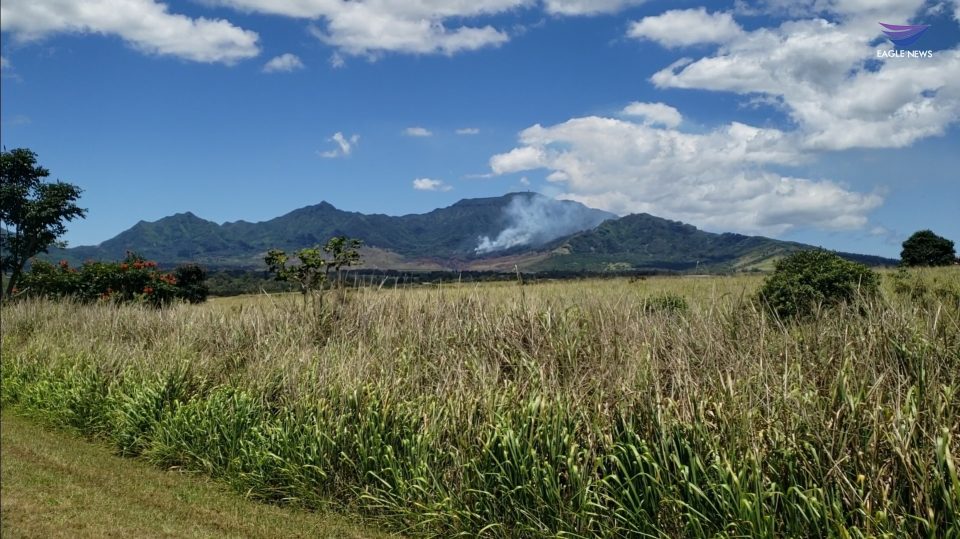By Alfred Acenas
Eagle News Service
HONOLULU (Eagle News) – Federal, state, and county agencies launched the “Wildfire & Drought LOOKOUT!” awareness campaign during a news conference on Wednesday, June 7, at the Kamilo Nui community in Hawaii Kai, East Oahu.
Hosted by the nonprofit Hawaii Wildfire Management Organization (HWMO), the event served as a collaborative effort by dozens of wildfire and water management representatives around the Aloha State in providing wildfire statuses and drought preparedness tips to residents, visitors, and businesses.

National Weather Service (NWS)
“Recent rainfall has provided some benefit for leeward (western) Kauai and Oahu, but moderate to extreme drought covers large portions of Oahu, Maui County, and the Big Island,” said Meteorologist Derek Wroe, of the NWS Honolulu Forecast Office (HFO).
“As people know, we are heading into the hotter and drier summer months, and projections call for rainfall to be below normal. As a result, drought will likely expand and worsen over the fire prone leeward areas. These drier-than normal-conditions may linger into the beginning of the normal wet season in October and November,” Wroe said.
He added that, according to the U.S Drought Monitor’s weekly reports, the islands of Molokai, Kahoolawe, Maui, and Hawaii have recently been showing areas of extreme drought; while Kauai is currently drought-free.
“There’s no reason to expect any relief from the drought,” Wroe warned. “We do expect the percentage of land in the extreme to exceptional drought categories to grow.”
University of Hawaii (UH)
Dr. Clay Trauernicht, an Ecosystems and Fire Extension Specialist at the University of Hawaii’s Department of Natural Resources and Environmental Management, has been studying the impacts of fires on natural systems.
“Most wildfires in Hawaii tend to be smaller in size when compared with other western states. However, most years, as a percentage of land area, Hawaii loses as much acreage to fire as all the large states on the West Coast,” Trauernicht described. “Fortunately, there is a lot we can do to protect our people and places from wildfire. We just all need to take preparedness action.”
State Department of Land and Natural Resources (DLNR)
Drought and wildfire conditions were evident from last week’s three-acre (1.2-hectare) fire at Kuaokalā at Oahu’s northwest corner.
According to DLNR State Wildfire Manager Mike Walker, the fire likely sparked from a roadside, unattended campfire, which had burned so hot and fast before wildland firefighters could put it out.
“In this same area, we’ve had four or more fire starts from unextinguished campfires,” Walker explained. “This forest and many others around the state are bone dry and getting dryer by the day.”
Forest visitors are continually reminded that ground fires are strictly prohibited on state-owned lands, which include State Forest Reserves and Natural Area Reserves; that campfires must be in a container such as in a barbeque grill or metal drum; and that all embers must be extinguished when the fire is unattended.
“We recommend campers and hikers carry extra water and fire extinguishers in their vehicles when in forested or vegetated areas, especially during dry, windy summer months,” Walker added.
Honolulu Fire Department (HFD)
HFD Inspector Carl Otsuka commended community members for instituting many of the protective steps, outlined by HFD and HWMO through the Hawaii-Firewise program.
“To protect their properties and their community, they’ve created fire breaks near structures [and] are keeping their rain gutters clear of debris and keeping trees and vegetation cut-back,” Otsuka commented.
HFD further noted that another linkage between drought and fire is that all the water from municipal fire hydrants is potable water. The more water needed for firefighting means less drinking water available, which could result in non-voluntary water restrictions if drought conditions worsen.
(Eagle News Service)
